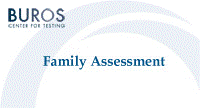Buros-Nebraska Series on Measurement and Testing

Family Assessment
Date of this Version
1995
Document Type
Article
Citation
Family Assessment, ed. Jane Close Conoley & Elaine Buterick Werth (Lincoln, NE: Buros Institute of Mental Measurements, University of Nebraska-Lincoln, 1995).
Abstract
This section presents information on the assessment of family constructs that are of interest to most families. Dr. James Bray tackles an area of family issues in which some confusion reigns. Bray addresses the dilemma of the multiple processes and constructs involved with family health with definitions of the most salient features of family functioning. These include communication, conflict, problem solving, emotional bonding, affect, roles, differentiation and individuation, triangulation, intimacy, personal authority in the family system, and family stress. Bray identifies valid and reliable self-report measures available to assess each construct and future research directions for the study of family health and distress. He advocates a multi-level approach to family assessment, consideration of cultural and ethnic influences, and precision in the measurement of factors associated with family functioning.
Dr. Jane Close Conoley and Lorrie E. Bryant expand upon Bray's call for a consideration of cultural and ethnic influences by posing the hypothesis that most assessment approaches are based on constructs identified as important in majority culture families. There are no commercially available instruments that were developed with American ethnic minorities or recent immigrants to the United States and none that contain sufficient minority families in the norm groups to allow for clearly valid interpretations. Conoley and Bryant urge clinicians to consider client behaviors in light of cultural expectations for family life, how different groups understand psychological distress, belief systems used by various ethnic groups regarding the etiology of psychological disorders and family dysfunction, acceptable interpersonal and interactional styles to families of color, and the level of acculturation that characterizes the family.
There is a growing interest in assessing the experience of siblings in a family. The role sibling relationships play in child and adult development and in family life is under intense scrutiny in current research literature. It is an area not well investigated by clinicians, but clearly of clinical importance. Michelle Schicke offers a review of methods and procedures used for the purpose of assessing sibling relationships including observation, interview, and rating scales. She addresses some of the problems inherent in current assessment practices and considerations involved in the planning of assessment of sibling relationships and compares the methods with an emphasis on the practical applications of measurement.
Marital quality is analyzed by Dr. David Johnson. He evaluates a number of approaches ranging from subjective reports of marital well-being to those that include both evaluative and behavioral components to those that differentiate between well-adjusting and failing marriages and those suitable for use with cohabiting couples. Johnson concludes his chapter by making five recommendations to scientists in the field regarding the future direction for further study of marital quality in terms of conceptualization, assessment, analysis, and research.
Included in
Educational Assessment, Evaluation, and Research Commons, Family, Life Course, and Society Commons, Quantitative, Qualitative, Comparative, and Historical Methodologies Commons


Comments
Copyright © 1995 by Buros Institute of Mental Measurements. Digital Edition copyright © 2012 Buros Center for Testing.